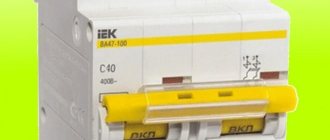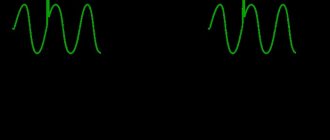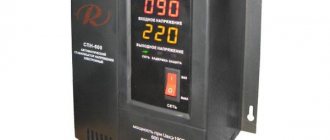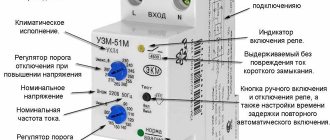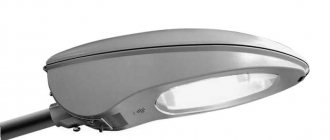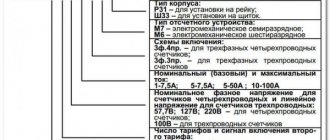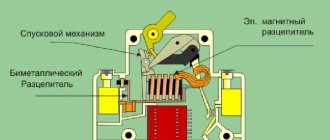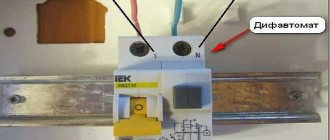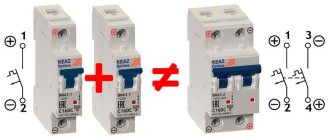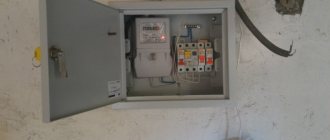General characteristics
A 25 ampere circuit breaker is a device whose main task is to ensure the safety of the electrical network from overcurrent, that is, from a short circuit with overload. Such equipment is turned on and off from an electrical circuit. Equipped with either an electromagnetic type of release or a combined one. This allows you to protect the circuit from short circuits and electrical overload. Its main advantage is the fact that it allows you to protect an electrical installation or transformer substation from short circuits, network overloads and breakdowns as a result of frequent network outages.
General technical specifications from the manufacturer
It has on its body markings of the rated current, switching capacity, current limiting class, rated breaking capacity and time-current response characteristics of the release system. The rated current value is 25 amperes, it can be lowered or increased when the temperature changes in the appropriate direction. The switching capacity is 4500 and 6000 amperes for a household unit, and the current limit is 10 milliseconds.
Note! The value of the time-current characteristic is less than 60 minutes, and the rated breaking capacity is from 1.13 In to 1.45 In.
General characteristics and markings
Single-pole circuit breaker 25 amperes
Electrical equipment operating in power circuits is presented with technical characteristics and standard markings. A number of parameters that determine the operation of the automatic device are taken as a basis.
Basic indicators
The functionality of any protective device is determined by:
- rated current;
- switching or breaking capacity;
- current limit class;
- time-current characteristics of electromagnetic and thermal releases.
Taken together, these indicators fully characterize it, and some of them are used in factory markings.
Extra options
Additional device parameters include:
- permissible load power that the machine can withstand;
- type of switching voltage (220 or 380 Volts);
- number of poles.
Unlike the main indicators relating directly to the switch, these parameters characterize the device by its operation in the serviced circuit. Using them, it is possible to distinguish a three-phase 25 Ampere machine, for example, from its single-phase analogue.
Depending on the number of poles, the devices are:
- single-pole;
- bipolar;
- three-pole and four-pole.
Bipolar
Three-pole
Four-pole
Each of them has a corresponding number of incoming and outgoing contacts and is used for specific purposes. Single-pole circuit breakers are installed in phase power circuits of 220 Volts (the earth conductor is not involved, since it is laid bypassing the switch). Two-pole 25 Ampere circuit breakers are needed for simultaneous switching of phase and ground wires and are used to organize entry into the apartment.
More functional 3-pole products are used in three-phase circuits (without a neutral core). A 4-pole device is selected when it is necessary to switch three phases and zero.
PUE allows the use of machine poles to control currents of various linear loads. The situation cannot be ruled out when phase is supplied to one of them from one line, and to the other from the second.
Marking
Marking of the circuit breaker
The marking applied to the C25 circuit breaker informs about the following parameters of the device:
- The symbol “C” means a current characteristic indicating a time delay in the operation of the tripping circuit.
- Numbers 25 are the rated current at which the machine operates for a long time without overload (in normal mode).
Below the markings on the front panel of the device there are symbols within frames indicating the current limit class and rated breaking capacity.
Marking
All types of technical characteristics presented are written on the equipment. The name of the brand and manufacturer is indicated at the very top. The line, time-current characteristic and rated current are indicated below. The following describes the rated voltage in fractions and the maximum shutdown current. The current limiting class is indicated at the very bottom or is not indicated at all. The terminal connection diagram is given on the opposite side of the model. The factory part number is placed on the reverse side.
Factory marked device
Description of the main parameters
The rated current of any (including double) 25 Ampere machine is indicated in its marking. It means the value at which the device operates for a long time without turning off. This parameter is entered taking into account the average air temperature of 30°C. If it decreases, it will increase, and if it increases, on the contrary, it will decrease.
The switching capacity of a circuit breaker characterizes its ability to instantly switch off at short-circuit currents of a certain magnitude. This indicator for household appliances takes typical values of 4.5 thousand or 6 thousand Amperes. In industrial designs it is indicated separately (without a square frame). The higher the switching capacity of the model, the higher quality the machine is considered and the more expensive it is.
The current limit class indicates how long it takes to extinguish an arc that occurs when switching high currents. There are 3 known classes of switches that differ in this parameter:
- In the third class, the arc goes out in 3-5 milliseconds.
- In devices of the second group, it takes 5-10 milliseconds to extinguish it.
- For devices of the first class, the restriction is not standardized. The process usually occurs in 10 milliseconds or more.
The class marking is applied to the body in the form of numbers 3 or 2 placed in a frame.
In any machine, two releases are used as actuating elements. One of them (thermal type) is made as a bimetallic plate, and the other is electromagnetic, which is an overcurrent relay. The first switches off the device when the current power is exceeded for a long time on the section of the line protected with its help. The electromagnetic release is triggered when there is a short circuit in the circuit. The current values at which the circuit breaker turns off, as well as time delays, are called its time-current characteristics.
Cable cross-section for automatic machine s25
It is important to understand that the C25 circuit breaker protects electrical equipment and people via cable. Thus, you need to buy the device according to the cable section. There is a special table that shows the cross-section and power for connecting to a network with one, two and three phases. The required cross section can be determined using Ohm’s law and summing up the maximum power of all equipment.
You might be interested in everything about phase-zero loops
Note! As a rule, a 3*4 section is chosen for a house.
Cable cross-section for single-phase network
Selection of circuit breaker rating for current and load power
To select a suitable machine, it is convenient to calculate the current per kilowatt of load power and draw up the corresponding table. Applying formula (2) and a power factor of 0.95 for a voltage of 220 V, we obtain:
1000 W / (220 V x 0.95) = 4.78 A
Considering that the voltage in our electrical networks often does not reach the required 220 V, it is quite correct to take the value of 5 A per 1 kW of power. Then the table of current versus load will look like this in Table 1:
| power, kWt | 2 | 4 | 6 | 8 | 10 | 12 | 14 | 16 |
| Current strength, A | 10 | 20 | 30 | 40 | 50 | 60 | 70 | 80 |
This table gives an approximate estimate of the strength of alternating current flowing through a single-phase electrical network when household electrical appliances are turned on. It should be remembered that this refers to peak power consumption, not average. This information can be found in the documentation supplied with the electrical product. In practice, it is more convenient to use the table of maximum loads, which takes into account the fact that machines are produced with a certain current rating (Table 2):
| Connection diagram | Current ratings of automatic machines | |||||||
| 10 A | 16 A | 20 A | 25 A | 32 A | 40 A | 50 A | 63 A | |
| Single-phase, 220 V | 2.2 kW | 3.5 kW | 4.4 kW | 5.5 kW | 7.0 kW | 8.8 kW | 11 kW | 14 kW |
| Three-phase, 380 V | 6.6 kW | 10,6 | 13,2 | 16,5 | 21,0 | 26,4 | 33,1 | 41,6 |
For example, if you need to find out how many amperes a machine needs for a power of 15 kW with a three-phase current, then we look in the table for the nearest larger value - it is 16.5 kW, which corresponds to a machine with a capacity of 25 amperes.
In reality, there are limitations on the allocated power. In particular, in modern urban apartment buildings with an electric stove, the allocated power is from 10 to 12 kilowatts, and a 50 A automatic machine is installed at the entrance. It is reasonable to divide this power into groups, taking into account the fact that the most energy-intensive appliances are concentrated in the kitchen and bathroom. Each group is equipped with its own machine, which eliminates the complete loss of power to the apartment in the event of an overload on one of the lines.
In particular, under an electric stove (or hob) it is advisable to make a separate input and install a 32 or 40 ampere machine (depending on the power of the stove and oven), as well as a power outlet with the corresponding rated current. You should not connect other consumers to this group. Both the washing machine and the air conditioner should have a separate line - a 25 A machine will be sufficient for them.
The question of how many sockets can be connected to one machine can be answered in one phrase: as many as you like. The sockets themselves do not consume electricity, that is, they do not create a load on the network. You just need to make sure that the total power of simultaneously switched on electrical appliances corresponds to the cross-section of the wire and the power of the machine, which will be discussed below.
For a private house or cottage, the input machine is selected depending on the allocated power. Not all owners are able to obtain the desired number of kilowatts, especially in regions with limited power grid capabilities. But in any case, as for city apartments, the principle of dividing consumers into separate groups remains.
Introductory machine for a private home
Scope of application
The machine, marked c25, is used as an input device, which is placed before the meter. Suitable for single, two and three phase networks. A single-pole and two-pole circuit breaker can be used for one electrical appliance with a power of 5.5 kilowatts. Three-pole can be used for equipment of 9.5 kilowatts.
It is most often used to protect an electric stove or other kitchen heating appliances. It can also be used to protect lighting system, motor, transformer and electronic appliance.
Switch for household needs
Areas of application and connection diagram
Input circuit breaker in the electrical panel
Two-pole and 4-pole circuit breakers for 380 Volts 25 Amps are most often installed at the input of the serviced facility, before the meter.
For input devices, the permissible power is no more than 5.5 kilowatts (kW) for a single-phase network and no higher than 9.5 kW for a 3-phase 25A circuit breaker.
Single-pole and double-pole devices are allowed to be used in the power supply circuits of individual consumers with a power of up to 5.5 kW, if only the input circuit breaker has a higher current rating. Their 3-pole and 4-pole analogues can be installed if it is necessary to protect the circuits of current collectors with a power of up to 9.5 kW (electric stoves and similar heating devices). Before installing a 25A 380V machine, you should calculate the permissible load by summing up the indicators for individual consumers. It is important to take into account the thickness of the supplied wires. The cable cross-section is determined from tables in which the required value is selected in accordance with the operating current of the device.
According to the PUE, protective devices whose designation contains the letter “C” are calculated using formulas for average characteristics and are considered universal. They can operate in a network to which various types of loads are connected (from a light bulb to an electric motor).
Connection diagram
Wiring diagram for a 25-amp machine
When connecting any machine, it is important to learn the following rule: the wires are always connected to it from the upper terminals, and are discharged from the bottom and go further to the load. There are exceptions to this rule; but then on the body of the device its special connection diagram is shown.
In a situation where, in addition to the numbers on the diagram or on the contacts of the machine, there is the letter N, a zero bus is connected to these terminals. If there is no designation on the case, it is connected to the contacts indicated by the last numbers. Phase and neutral conductors are always connected on the same side.
It is important to know the order in which the device is included in the overall power supply circuit. It is always installed before the RCD, since for normal operation it requires a phase conductor and ground, and a linear machine switches one phase. However, they are usually mounted on a common DIN rail located in the distribution cabinet next to the meter.
Machine connection diagram
It is best to entrust the connection of the circuit breaker to a professional. If you need to connect yourself, below is a popular diagram for a single-phase network.
Note! The introductory type of machine must have two energy ratings in order to achieve selectivity of the thermal load.
The simplest connection diagram according to the instructions
Device cost
As of September 2022, 25 volt automatic electrical switches are produced by foreign companies ABB, Schneider Electric, Legrand and domestic organizations KEAZ, IEK, EKF.
Switch c25 ABB
The price of a three-phase packager ranges from 64 to 2000 rubles. The cost depends on technical characteristics, throughput, quality and brand.
Switch s25 KEAZ
The 380 volt 25 ampere machine will be useful for users who experience frequent power outages, network overload and short circuits. This is an inexpensive device that is very easy to connect to the network following the instructions. It is used for household needs and has factory markings. It has optimal characteristics for long and reliable use.
ABB automatic machines of the S200 and SH200L series
The S200 series circuit breakers belong to the professional segment of ABB switches.
The wide range includes devices suitable for household electrical installations, commercial and complex industrial systems. They have convenient double clamps that allow you to simultaneously connect two conductors, both from below and from above. It is possible to connect additional accessories. S200 circuit breakers are available in one-, two-, three- and four-pole versions, with tripping characteristics of B, C, D, K and Z. SH200L circuit breakers are a lightweight version of the S200 series devices, part of the Compact Home line for residential and small office premises. The cost reduction of this series was achieved by reducing the nominal switching capacity and reducing the model range. Not recommended for use as introductory machines. In addition, there is no possibility of connecting additional signaling and control devices. Like the older series machines, they are supplied in one-, two-, three- and four-pole versions, with a response characteristic of C.
| Specifications | S200 | SH200L |
| Rated current | 0.5–63 A | 6–40 A |
| Voltage | 230/400 V | |
| Rated breaking capacity | 6, 10, 15 and 25 kA | 4.5 kA |
| Connected cable cross-section | up to 25 mm2 | |
All circuit breakers are supplied through official channels from factories in Germany. By purchasing ABB automatic machines in our store, you can be sure of the high quality of the supplied goods.
For detailed information about the line of machines.
